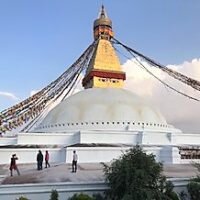Buddhism
What is Buddhism?
The Buddha showed us that the potential for Buddhahood exists right here and now in all of us. We all have incredible potential for wisdom and compassion, but we are caught in chasing figments of our imagination. These figments are an attitude of self clinging and self cherishing, thinking that this will bring us happiness.
Buddha showed us the path to cultivate the potential for Buddhahood and to achieve lasting freedom, including limitless compassion, wisdom and energy.
Following the Path
The path itself consists of three main elements: ethical behavior, meditation and wisdom.
Ethical behavior means being mindful of the way we think and act and speak. Mindfulness enables us to let go of self-indulgence and relate to others in a way that puts their needs first. In meditation we begin to calm the turbulence of thoughts and feelings and develop insight into our mind and our experience of the world. Through wisdom, we gradually come to understand how things really are.
Sakya Buddhist Center provides classes that introduce you to the three trainings, provide support from fellow practitioners and facilitate visits by Buddhist masters who transmit the authentic teachings of the tradition.
The Buddhist Teachings
Buddha’s teaching were transmitted orally from one generation to the next, as was the custom in India, and centuries later gathered together and written down to form ‘The Three Baskets’ (Tripitaka) or collections of Buddhist teaching:
Sutras – The collection of Buddha’s oral teachings.
Vinaya – The rules of ethical behavior for monks, nuns and lay people.
Abhidharma – Philosophical teachings on the true nature of phenomena.
In addition, there is the collection of esoteric Buddhist teachings given by the Buddha in the tantras.
Subsequently, the great Indian and Tibetan Buddhist masters composed explanatory teachings that summarize and elaborate on specific topics to help students study and practice. These are known as ‘shastras’.
The Three Vehicles
The teachings of the Three Baskets and tantras can also be grouped as the ‘Three Vehicles’:
The Hinayana (Lesser Vehicle) – The collection of practices that lead to nirvana and freedom from personal suffering. We enter the Hinayana by taking refuge at which point we become a Buddhist.
The Mahayana (Great Vehicle) – The collection of practices that lead to Buddhahood for the benefit of all all beings. We enter the Mahayana by taking the bodhisattva vow.
The Vajrayana (Indestructible Vehicle) – A special collection of Mahayana practices taught in the tantras that lead more swiftly to Buddhahood. We enter the Vajrayana by taking initiations.
They are called ‘Vehicles’ as their practice will take us to a particular destination, ultimately to Buddhahood.

“I pray that all partisan anger and hatred that we carry in our hearts be dissolved….”
— Lama Jampa Thaye, Message for Buddha Day, May 31, 2020




